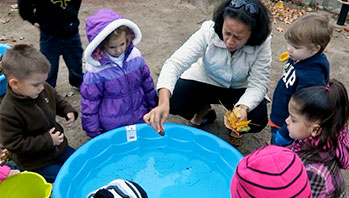- construction paper
- large leaves
- markers
- paper towel
- plastic pipettes or eyedroppers
- plexiglass sheet
- science notebooks
- small containers of water
- sponges
- toothpicks
- absorb
- drip
- drop
- flow
MA Standards:
Language/L.PK.MA.6: Use words and phrases acquired through conversations, listening to books read aloud, activities, and play.
MA Draft STE Standards:
Earth and Space Sciences/Earth’s Systems/ESS2.A: Observe, investigate, and classify the non-living materials, natural and human made, in their environment.
Head Start Outcomes:
Logic and Reasoning/Reasoning and Problem Solving: Classifies, compares, and contrasts objects, events, and experiences.
Science Knowledge/Scientific Skills and Method: Observe and discuss common properties, differences, and comparisons among objects.
Science Knowledge/Scientific Skills and Method: Collects, describes, and records information through discussions, drawings, maps, and charts.
Science Knowledge/Conceptual Knowledge of Natural and Physical Worlds: Observes, describes, and discusses properties of materials and transformation of substances.
PreK Learning Guidelines:
English Language Arts/Language 2: Participate actively in discussions, listen to the ideas of others, and ask and answer relevant questions.
Science and Technology/Inquiry Skills 4: Record observations and share ideas through simple forms of representation such as drawings.
Science and Technology/Physical Sciences 19: Explore, describe, and compare the properties of liquids and solids found in children's daily environment.
Explore Together (outdoors): Make More Drops

© Commonwealth of Massachusetts, Department of Early Education and Care. All rights reserved.
STEM Key Concepts: Water can flow quickly or slowly; Water in small amounts forms drops; Water drops stick together; Water behaves differently on different surfaces
ELA Focus Skills: Listening and Speaking, Vocabulary
Take children outdoors and have them freely explore water drops. Explain that they are going to observe how water drops behave on different surfaces. Say, Then you can compare and describe how the drops behave on different surfaces.
Have children freely explore water drops using the new materials. Encourage them to discuss how some surfaces absorb the water and on surfaces the drops flow quickly. As children explore, listen and engage when you see an opportunity to expand their curiosity. Ask questions such as,
- What do you think will happen if you put water drops on your arm? Try it and find out.
- What do you think raindrops will do if they land on that leaf? Do you think they will move the same way as the drops you made by dripping water on the leaf?
Encourage children to use the eyedroppers to put water drops on a smooth, vertical surface such as the sheet of plexiglass so they can compare how the drops flow on the different surfaces. Ask questions such as,
- What was the same or different about how the water drops behaved on the smooth surface and on the dry sponge surface?
- Were you surprised at how the water behaved when you dripped it on the construction paper? What did you predict it would do?
After children have had time to explore, encourage them to draw a picture showing what happens to the water drops on one of the new surfaces they explored. Encourage them to include as much detail as possible.
Reflect and Share
Once inside, have children share their observations. Encourage them to use their drawings to describe what they observed. You may want to have children compare the observations they made today to ones they made earlier in the week. Ask,
- What happened to the water drop when you put it on the sponge? How is that different from when you put it on the wax paper?
- Why do you think the water moved differently?
- What is different about the plastic mirror and the sponge surfaces?
Encourage children to think about how one surface absorbs water and another repels it.
Adaptation: You might prefer to have very young children do the activity individually, with one-to-one supervision.
